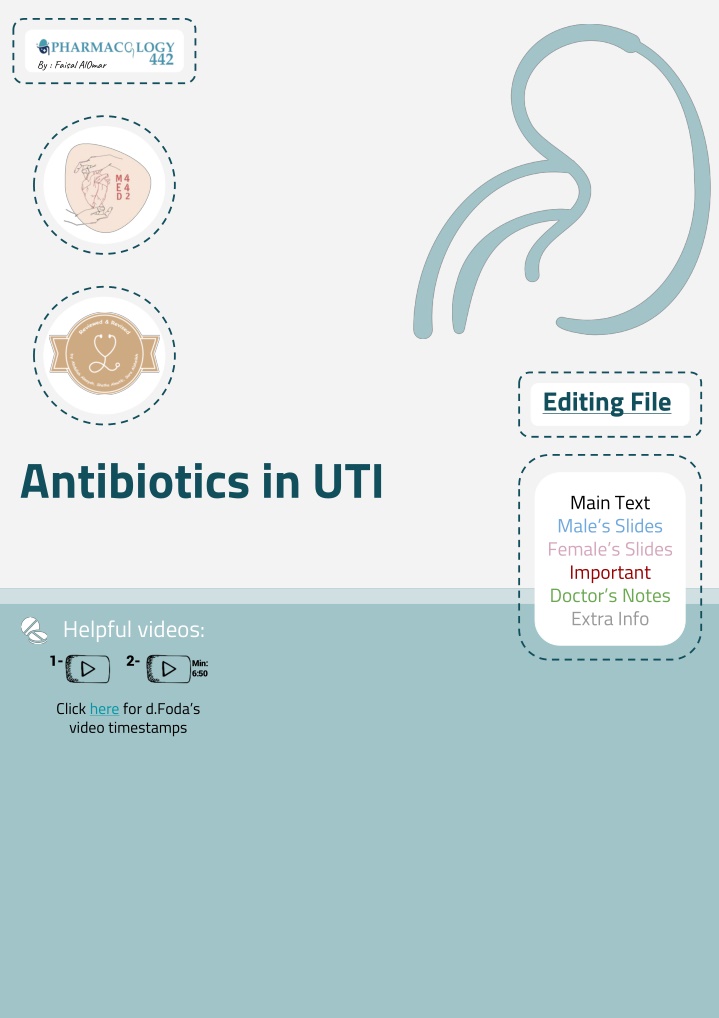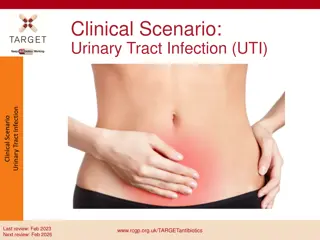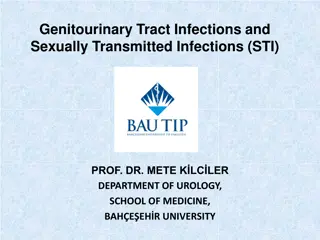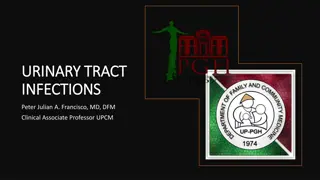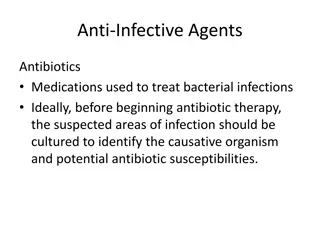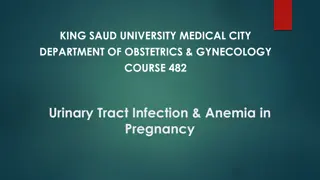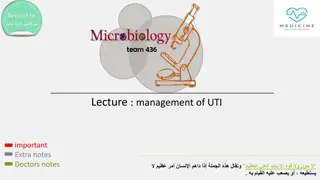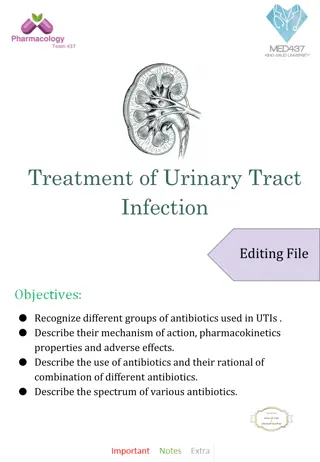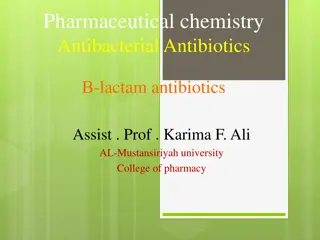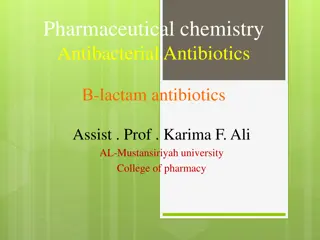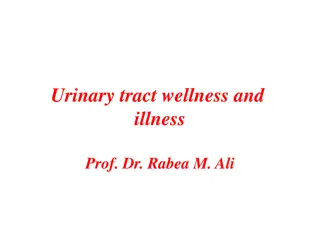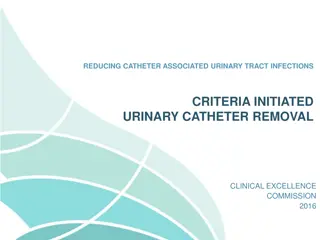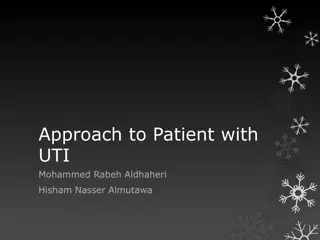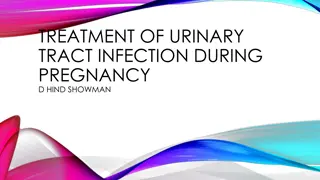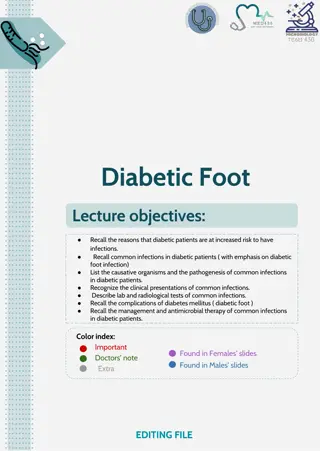Urinary Tract Infections (UTIs) and Antibiotics: A Comprehensive Overview
Urinary Tract Infections (UTIs) are a common issue, more prevalent in women, with causes ranging from poor hygiene to underlying health conditions. The content delves into the classification of UTIs, their main causes, and bacteria responsible for infections. It also covers the complications of UTIs and outlines various antibiotics used for treatment, including Co-trimoxazole, Nitrofurantoin, and Cephalosporins. Understanding these aspects is crucial for effective management of UTIs.
Download Presentation

Please find below an Image/Link to download the presentation.
The content on the website is provided AS IS for your information and personal use only. It may not be sold, licensed, or shared on other websites without obtaining consent from the author.If you encounter any issues during the download, it is possible that the publisher has removed the file from their server.
You are allowed to download the files provided on this website for personal or commercial use, subject to the condition that they are used lawfully. All files are the property of their respective owners.
The content on the website is provided AS IS for your information and personal use only. It may not be sold, licensed, or shared on other websites without obtaining consent from the author.
E N D
Presentation Transcript
By : Faisal AlOmar Editing File Editing File Antibiotics in UTI Main Text Male s Slides Female s Slides Important Doctor s Notes Extra Info Helpful videos: 1- 2- Min: 6:50 Click here for d.Foda s video timestamps
EXTRA (Respiratory Block, team438) Beta-Lactams E.g. Cephalosporins Prefix: Cef or Ceph Sulfanilamide Aminoglycosides Suffix: sulfa Suffix: mycin Antibiotics Classification (Not mentioned in this lecture) Macrolides Tetracyclines Quinolones Suffix: thromycin Suffix: cyclin Suffix: floxacin Antibiotics Mechanism of Action Bacteriostatic Stops the growth by: Bactericidal Kills the bacteria by destroying: Affecting Protein Synthesis e.g. - Tetracyclines - Macrolides - Aminoglycosides 2-Nucleic acid (DNA or RNA) e.g. - Quinolones (DNA) - Rifampin (RNA) - TMP-SMX (Folate) 1- Cell wall e.g. Cephalosporins EXCEPTION: Aminoglycosides affects the protein synthesis but is considered bactericidal
Urinary Tract Infection 1 2nd most common infection (after RTIs). 2 Often associated with some obstruction of the flow of urine. 3 More common in women more than men 30:1 (Why?) short urethra in women. 4 Incidence of UTI increases in old age (10% of men & 20% of women). Classification: Lower UTIs (Bladder, Urethra & Prostate): Cystitis, Urethritis & Prostatitis More common & easier to treat Upper UTIs (kidney & Ureters): Pyelonephritis More serious & difficult to treat Causes of UTI: Normally urine is sterile. Bacteria comes from digestive tract to opening of the urethra Enlargement of prostate gland in men (common cause) Obstruction of the flow of urine (e.g. kidney stone) Not drinking enough fluids Because water flushes bacteria away Catheters placed in urethra & bladder Large uterus in pregnant women presses on the bladder Waiting too long to urinate Disorders that suppress the immune system (diabetes & cancer chemotherapy). Poor toilet habits (wiping back to front for women)
UTI Can Be Complicated Simple Infections spread to other parts of the body and resistant to many antibiotics. Thus more difficult to cure, {due to hospital-acquired bacteria (E.coli , Klebsiella , Proteus , Pseudomonas , Enterococci , Staphylococci)} Infections do not spread to other parts of the body and go away readily with treatment (due to E.coli in most cases). Bacteria Responsible for UTIs Mainly E.coli (approx. 80% of cases) Proteus mirabilis Klebsiella Pseudomonas aeruginosa Mycoplasma, Chlamydia trachomatis, & N.gonorrhea. Limited to urethra, unlike E.coli may be sexually transmitted. Gram -ve (Most common) Gram +ve (less common) Staphylococcus Saprophyticus (approx. 20%) Treatment of UTIs 01 Co-trimoxazole (SMX/TMP). P.o. Two drugs combination in one tablet P.o.= taken orally 02 Nitrofurantoin P.o. 03 Tetracyclines E.g. Doxycycline (P.o.) 04 Aminoglycosides E.g. Gentamicin (I.M , I.V) 05 Cephalosporins E.g. Ceftriaxone & Ceftazidime. (I.V) 06 Quinolones E.g. Ciprofloxacin (P.o.)
Co-trimoxazole (TMP-SMX) Trade names: Bactrim and Septra Sulfamethoxazole Trimethoprim Drug Inhibit gram-ve & gram+ve bacteria Alone, each drug is bacteriostatic but together they are bactericidal(synergism) potentiate the efficacy. The optimal ratio of TMP to SMX in vivo is 1:20. formulated 1(TMP): 5(SMX). Ex: 160 mg TMP + 800 mg SMX; 80 mg TMP + 400 mg SMX; 8 mg TMP + 40 mg SMX) not important Overview Both drugs stop folic acid production in microorganisms. in microorganisms: PABA is turned into dihydrofolate by dihydropteroate synthetase (SMX disturbs this step). dihydrofolic acid is turned into tetrahydrofolate by dihydrofolate reductase (TMP inhibits this enzyme). Mechanism of action ** PABA: para aminobenzoic acid **Sulfamethoxazole is an example of sulfonamide group. More lipid soluble. A weak base, concentrates in prostatic and vaginal fluid (> acidic than plasma). General Information - Mainly given orally or IV Distribution. Rapidly absorbed from stomach and small intestine. Widely distributed to tissues and body fluids (including CNS, CSF), placenta & fetus. Usually given orally or IV, alone or in combination with SMX. Well absorbed from the gut. Widely distributed in body fluids & tissues (including CSF). Absorption and Distribution Pharmacokinetics Protein binding 70% of absorbed SMX is bound to serum proteins. 40% protein bound. Metabolized by acetylation in the liver. Eliminated in urine partially unchanged and partially acetylated. Metabolism and excretion 60% of TMP or its metabolite is excreted in the urine. 1- GIT: Nausea, vomiting 3- Hematologic: A- Acute hemolytic anemia. (caused by: hypersensitivity, G6PD** deficiency). B- Megaloblastic anemia (in TMP). **Critical for the proper function of RBCs ADRs 2- Allergy* *Common sulfonamides ADR Displace bilirubin-if severe kernicterus displace bilirubin from its albumin-binding sites in plasma crosses BBB brain damage for the neonates. Potentiate warfarin, oral sulfonylurea hypoglycemics (Anti-diabetic group). Drug Interactions 1. Pregnancy. 4. Infants under 6 weeks. 2. Nursing mother. 5. Renal or hepatic failure. 3. Blood disorders. ) ( Contraindications
Nitrofurantoins Drug Bactericidal for gram -ve and gram +ve bacteria. Effective against E.coli & Staph. Saprophyticus. Other common UT gram -ve bacteria may be resistant. Antibacterial spectrum Sensitive bacteria reduce (convets) the drug to an active agent (by bacterial reductase) that inhibits various enzymes and damages DNA. Mechanism of action Complete and rapid oral absorption. 75% metabolized & is excreted so rapidly that no systemic antibacterial action can be achieved. Concentrated in urine (25% excreted unchanged) Urine pH is kept <5.5 (acidic) to enhance drug activity, so we should avoid anything that makes the urine alkaline such as antacids. Urine turns to dark orange-brown (harmless). Pharmacokinetics Used as urinary antiseptic. It s usefulness is limited to lower uncomplicated UTI s and cannot be used for upper UT or systemic Infections, because it has weak systemic absorption Therapeutic uses Long acting: 100mg twice daily. Dose 50-100mg, orally, 6h/7 days. Not important GI disturbances: (Must be taken with food)* 1. Bleeding of the stomach 2. Nausea 3. Vomiting 4. Diarrhea Headache & Nystagmus (Involuntary eye movements) Hemolysis (in patients with G6PD deficiency). Side effects Patients with G6PD deficiency Anemia. Neonates interferes with immature enzyme systems in RBCs hemolytic anemia. Pregnant women especially towards the end of pregnancy (after 38 wks of pregnancy), risk of hemolytic anemia in newborn. Contraindications
Tetracyclines Doxycycline (long acting tetracycline) Drug Bacteriostatic, inhibits protein synthesis by binding reversibly to 30s ribosomal subunit. Mechanism of action Against gram +ve and gram -ve bacteria. Long acting Usually given orally Absorption is 90-100% Absorbed in the upper small intestine and best in absence of food Food, divalent & trivalent cations (Ca2+, Mg2+, Fe2+, AL3+) impair absorption and reduce its effectiveness (avoid dairy products) Protein binding 40-80% Distributed well, including CSF (Cerebrospinal fluid) Cross placenta and excreted in milk Largely metabolized in the liver Easily binds to calcium Pharmacokinetics Treatment of UTIs due to many gram -ve and gram +ve bacteria including Mycoplasma and Chlamydia. Therapeutic uses Prostatitis Dose 100mg orally, twice a day for 7 days. Not important GIT: Nausea, vomiting, diarrhea and epigastric pain (give with food that doesn t contain calcium) Thrombophlebitis I.V Hepatic toxicity (prolonged therapy with high dose) Brown discolouration of teeth children Deformity or growth inhibition of bones children Phototoxicity (sensitivity to sunlight) Vertigo Superinfections (alter the intestinal flora due to broad spectrum activity) Side effects Thanks to 439! Pregnancy Breast feeding Children (below 10 years) because it binds to Calcium in bones and teeth Contraindications
Aminoglycosides Gentamicin Drug Inhibit protein synthesis by binding to 30S ribosomal subunits irreversibly. Bactericidal, active against gram-ve aerobic bacteria. Mechanism of action poorly absorbed orally (highly charged). Given I.M or I.V Excreted unchanged in urine. More active in alkaline medium. Cross placenta (Contraindicated in Pregnancy). Pharmacokinetics Therapeutic uses Severe infections caused by gram negative organisms (pseudomonas or enterobacter) infection. Ototoxicity Nerve damage (e.g. vestibular nerve damage ) Neuromuscular blocking effect Cephalosporins Nephrotoxicity Adverse effects Grey text is not in the slides but females Dr said: you should know the details. 1st generation: Cephalexin 2nd generation: Cefuroxime-Cefaclor 3rd generation: Ceftriaxone and Ceftazidime Tri= 3rd generation. Drug Mainly Gram -ve Bacteria Mainly effective against gram-ve bacteria Spectrum Gram +ve Bacteria Acts by inhibition of cell wall synthesis Bactericidal Mechanism of action Route of administration Orally Parenterally Therapeutic uses Given in severe/complicated UTIs. Given in acute prostatitis. - Given parenterally & orally Relatively lipid insoluble (like penicillins). do not penetrate cells or the CNS except for 3rd generation. Mostly excreted unchanged by the kidney (glomerular & tubular secretion). Probenecid slows their elimination & prolongs their half lives. Half-life: 30-90 min, except ceftriaxone (4-7 hr). Pharmaco- kinetics Hypersensitivity reactions Thrombophlebitis Superinfections Diarrhea ADRs
Grey text is not in the slides but females Dr said: you should know the details. Fluoroquinolones Moxifloxacin, Gatifloxacin, Levofloxacin Ciprofloxacin Drug G-ve & G+ve bacteria. Highly active against Pseudomonas species. Active against gram-ve aerobic organisms. Spectrum Given oral or parenteral Concentrates in many tissues (kidney, prostate, lung, and bones/joints) Excreted mainly through kidney Relatively long half-life Given once daily, except Ciprofloxacin is given twice daily P.K Mechanism of action Inhibits DNA gyrase enzyme* and cell division resulting in bacterial cell death. *An enzyme involved in DNA supercoiling UTI caused by multidrug resistance organisms as pseudomonas. Prostatitis (acute/chronic) Therapeutic uses - GIT: Nausea, vomiting, diarrhea. CNS effects: (confusion, insomnia, headache, anxiety). Damage of growing cartilage (reversible arthropathy). Phototoxicity (avoid excessive sunlight). Adverse effects Not recommended for patients younger than 18 years Pregnancy Breast feeding women Contraindications
MCQs 1- A 3-weeks infant diagnosed with UTI, which of the following is contraindicated? 2- Which one of the following drugs has Megaloblastic anemia as an adverse effect? A-Gentamicin B-Ceftazidime C-Ceftazidime D-Co-trimoxazole A-Sulfamethoxazole B-Trimethoprim C-Ciprofloxacin D-Gentamicin 3- Which one of the following Antibiotics enhance the efficacy of Warfarin? 4- Which of these is NOT true about gentamicin? A- Mainly effective against anaerobic gram -ve bacteria B- Can be given through IV C- May cause nerve damage D- Contraindicated in pregnant women A-Co-trimoxazole. B-Gentamicin. C-Nitrofurantoins. D-Ceftriaxone 5- A patient contracted a UTI which spread to other parts of the body, what is a good antibiotic to give? 6- An antibiotic was given to a 15 year old and they came back to the hospital with pain in their joints, what antibiotic was given? A- Doxycycline B- Nitrofurantoin C- Ceftriaxone D- Trimethoprim SAQs A- Nitrofurantoin B- Sulfamethoxazole C- Gentamicin D- Ciprofloxacin 1- What is the mechanism of action of Trimethoprim? 3- List the uses of 3rd generation cephalosporins 2- List 3 ADRs of Nitrofurantoins 4- What reduces the effectiveness of tetracyclines? SAQs Answers: MCQs Answers: 1- Slide 5 2- Slide 6 3- Severe/complicated UTIs and Acute prostatitis 4- Food, trivalent and divalent cations 1-D 4-A 2-B 5-C 3-A 6-D
MCQs 7- A 31-year-old pregnant woman diagnosed with UTI, which of the following is contraindicated in her condition? 8- What is the mechanism of action of Doxycycline? A- Inhibits protein synthesis by binding to 30s ribosomal subunit B- Inhibits DNA gyrase enzyme C- Inhibits cell wall synthesis D- Inhibits protein synthesis by binding to 50s ribosomal subunit 10- Which one of the following drugs is bactericidal ? A- Gentamicin B- Ciprofloxacin C- Doxycycline D- All of them 9- Which one of the following drugs is the best choice in case of UTI caused by multidrug resistance organisms? A-Trimethoprim B-Tetracyclines C-Ceftazidime D-Sulfamethoxazole A- Gentamicin B- Doxycycline C- Nitrofurantoins D- Ciprofloxacin 12- one of the common causes of UTI in men is? 11- Which one of the following drugs is Bacteriostatic? A-over-drinking fluids B-Large uterus C-short urethra D-Enlargement of prostate gland A-Doxycycline B-Quinolones C-Rifampin D-Ceftriaxone SAQs 5- Mention the mechanism of action of Doxycycline and two possible side effects? 6- Mention two drugs that act by inhibiting protein synthesis and 2 of their side effects? 7-give me two examples of antibiotics that Kills the bacteria by destroying Nucleic acid ? 8- List 3 ADRs of Aminoglycosides? SAQs Answers: 5- Inhibits protein synthesis by binding reversibly to 30s ribosomal subunit / Phototoxicity and vertigo 6- a) Gentamicin; Ototoxicity and nephrotoxicity b) Doxycycline; Nausea and hepatic toxicity 7- Quinolones (DNA) - Rifampin (RNA) 8- Ototoxicity - Nephrotoxicity -Neuromuscular blocking effect MCQs Answers: 7- C 10-C 8- A 11-A 9- D 12-D
Pharmacology Team 442 Team Leaders Mishal Alsuwayegh Dena Alsuhaibani Team Members Faris Alseraye Farah Alfayez Mohammad Alrashed Atheer AlKanhal Abdullah Alsalem Shaden albassam Faisal Alomar Aljazi AlBabtain Saif Alotaibi Rahaf Almotairi Rakan Alromayan Mayssam Aljaloud Ahmed Alemam Farah Alqazlan Saad Almogren Nourah Alfawaz Rand Jarallah Naif Alobeily Abdullah Almawash Theme was done by Mohammad Alrashed Special thanks to Shatha Alshabani & Arob Alasheikh
